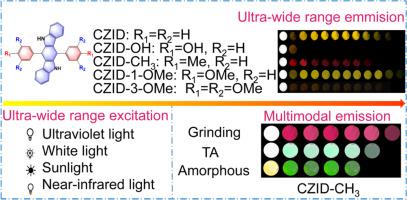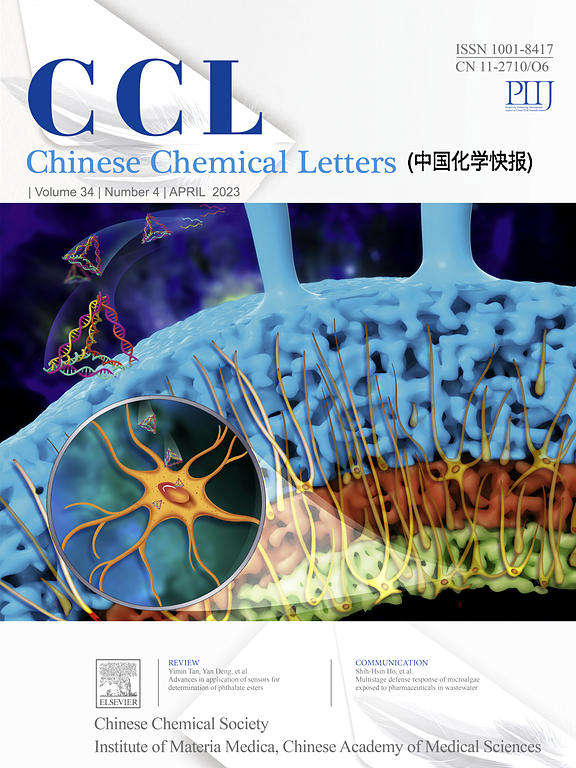超越晶体限制的多层次刺激响应智能有机余辉材料:水相双发射余辉和超宽范围激发下的上转换余辉
IF 8.9
1区 化学
Q1 CHEMISTRY, MULTIDISCIPLINARY
引用次数: 0
摘要
有机余辉材料在信息存储、防伪、生物成像等方面具有重要的应用潜力。然而,能够同时进行超宽范围激发和发射的余辉材料的研究还很有限。为了提高强发射单组分有机余辉系统的实用性,克服晶体或其他刚性环境的限制是必不可少的。我们利用单分子末端基团调控策略,在可见光激发下开发了固态双持久热激活延迟荧光(TADF)和室温磷光(RTP),发射范围从黄色到红色。RTP的生存期从4.19 ms增加到399.70 ms。这些余辉材料具有200 nm至800 nm的超宽吸收范围,使其能够被阳光模拟器和近红外辐射激发。808 nm激发下的上转换磷光寿命达到13.72 μs。这些化合物的双重持续排放对温度敏感。此外,在磨削或热处理后,由于激发态构象的平面化和额外的高效kRISC生成,伴随着广泛的余辉颜色转换。此外,熔融后非晶态退火有利于余辉由黄色向绿色转变。至关重要的是,这些化合物还在水和酸碱环境中保持稳定的超长余辉发射。总的来说,我们已经成功开发了一系列单组分智能发光材料,这些材料显示出显著的优势,包括双TADF和RTP发射,可调节的余辉寿命,广泛的激发和发射波长,不受晶体状态限制的多模态发光,以及在具有挑战性的环境中强大的余辉性能,为余辉材料在工程应用中的实际部署奠定了基础。上转换余辉发射在生物成像领域也具有广阔的应用前景。本文章由计算机程序翻译,如有差异,请以英文原文为准。

Multilevel stimulus-responsive smart organic afterglow materials beyond crystal limitations: Aqueous-phase dual emission afterglow and upconversion afterglow under ultra-wide range excitation
Organic afterglow materials hold significant potential for applications in information storage, anti-counterfeiting, and biological imaging. However, studies on afterglow materials capable of ultra-wide range excitation and emission simultaneously are limited. To enhance the practicality of strong emission single-component organic afterglow systems, overcoming the constraints of crystalline or other rigid environments is essential. We have developed solid-state dual-persistent thermally activated delayed fluorescence (TADF) and room temperature phosphorescence (RTP) emissions spanning yellow to red under visible light excitation, utilizing a single-molecule terminal group regulation strategy. The RTP lifetime extends from 4.19 ms to 399.70 ms. These afterglow materials exhibit an ultra-wide absorption range from 200 nm to 800 nm, rendering them capable of being excited by both sunlight simulator and near-infrared radiation. The upconversion phosphorescence lifetime under 808 nm excitation reaches 13.72 μs. The double persistent emission of these compounds is temperature-sensitive. Moreover, following grinding or heat treatment, accompanied by extensive afterglow color conversion due to planarization of excited state conformations and additional efficient kRISC generation. In addition, the amorphous state post melt annealing facilitates the afterglow transition from yellow to green. Crucially, these compounds also maintain stable ultra-long afterglow emission in aqueous and acid-base environments. Overall, we have successfully developed a series of single-component intelligent luminescent materials that demonstrate significant benefits, including dual TADF and RTP emissions, adjustable afterglow lifetimes, a broad range of excitation and emission wavelengths, multi-modal luminescence not restricted to crystalline states, and robust afterglow performance in challenging environments, setting the stage for the practical deployment of afterglow materials in engineering applications, the upconversion afterglow emission also holds promising potential for applications in the field of biological imaging.
求助全文
通过发布文献求助,成功后即可免费获取论文全文。
去求助
来源期刊

Chinese Chemical Letters
化学-化学综合
CiteScore
14.10
自引率
15.40%
发文量
8969
审稿时长
1.6 months
期刊介绍:
Chinese Chemical Letters (CCL) (ISSN 1001-8417) was founded in July 1990. The journal publishes preliminary accounts in the whole field of chemistry, including inorganic chemistry, organic chemistry, analytical chemistry, physical chemistry, polymer chemistry, applied chemistry, etc.Chinese Chemical Letters does not accept articles previously published or scheduled to be published. To verify originality, your article may be checked by the originality detection service CrossCheck.
 求助内容:
求助内容: 应助结果提醒方式:
应助结果提醒方式:


